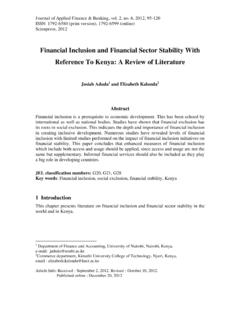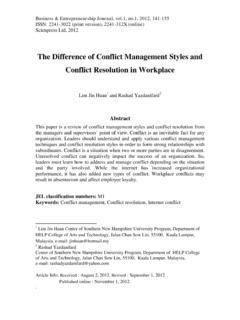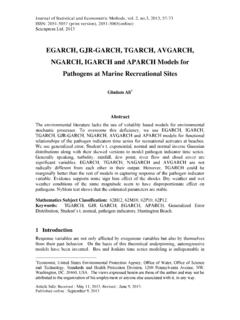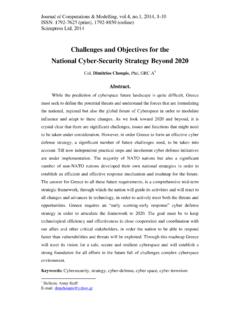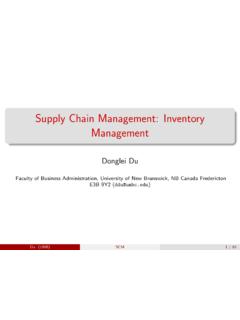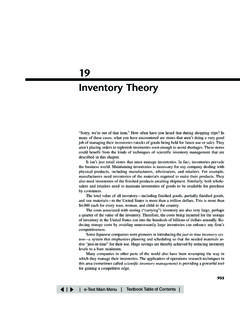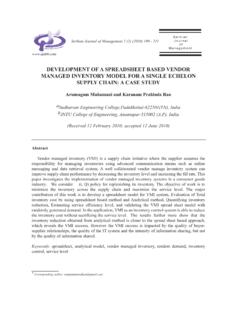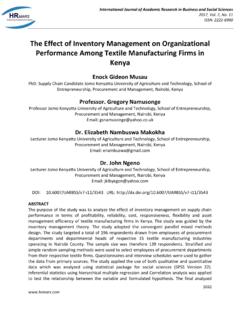Transcription of Analysis of a Production Order Quantity Model With ...
1 Advances in Management & Applied Economics, , , 2012, 179-189. ISSN: 1792-7544 (print version), 1792-7552 (online). International Scientific Press, 2012. Analysis of a Production Order Quantity Model with Declining Unit Cost Rod D. Raehsler1, Yifan Zhao2, Chin W. Yang3, Soong N. Sohng4, Paul Kim5 and Ken Hung6. Abstract This paper improves upon the existing literature surrounding the Production Order Quantity inventory Model in which unit cost and daily Production are assumed to be constant. By including economies of scale into the Model , we examine its impact on Production Order Quantity and total cost. The results suggest that the minimal cost solution derived from the Production Order Quantity Model needs to 1. Department of Economics, Clarion University of Pennsylvania, Clarion PA 16214, e-mail: * Corresponding author.
2 2. Department of Economics, Clarion University of Pennsylvania, Clarion PA 16214. 3. Department of Economics, Clarion University of Pennsylvania, Clarion PA 16214, e-mail: 4. Department of Economics, Clarion University of Pennsylvania, Clarion PA 16214, e-mail: 5. Department of Marketing, Clarion University of Pennsylvania, Clarion PA 16214, e-mail: 6. Sanchez School of Business, Texas A&M International University, Laredo TX 78041, e-mail: Article Info: Received : February 15, 2012. Revised : May 20, 2012. Published online : May 31, 2012. 180 Analysis of a Production Order Quantity Model .. balance out holding, setup and Production costs. As a result, a smaller inventory level corresponding to a minimum unit Production cost is found to be preferred. JEL classification numbers: C61, M11. Keywords: Production Order Quantity , Economic Order Quantity 1 Introduction A common inventory Model heavily utilized in the literature is the economic Order Quantity Model where fixed daily demand, zero lead time, constant holding cost and ordering cost are assumed.
3 inventory velocity, the speed at which components move through the operation chains, is sometimes used as a measure of the company's performance index [9]. For example, it is claimed by the company CEO, Michael Dell, that the Dell computer is of a higher quality if fewer inventories are on the floor of company warehouses. [10] In this line of Analysis , some authors have even gone so far as to refer to existing product inventories as the root of all evil in the business world. [1] At the other end of the spectrum concerning inventories, a high stock of heating oil in the presence of a severe winter and rising price typically enhances profit. As a consequence, the industry type and business characteristics are important considerations when applying any empirical Model to real business Analysis . The variation in how inventories are viewed by management reflects the important role inventory itself plays in an increasingly competitive Production environment.
4 It is worth noting that this is an environment in which a large stock of inventory is often discouraged given higher Production costs and greater degrees of business uncertainty. In this scenario, lean Production and a minimum level of product inventory necessary to meet consumer demand is preferred. [4] [12] [16] An application of this approach is described in Uzsoy, Lee, and Martin-Vega [15] by illustrating the importance of Production Raehsler, Y. Zhao, Yang, Sohng, P. Kim and K. Hung 181. planning and scheduling models in the semiconductor industry. The problems of random yields, complex product flows and rapidly changing technologies render performance evaluation and product planning extremity difficult in this environment. While the economic Order Quantity Model applies to the situation in which managers of a continuous review system choose the best Order Quantity , it does not address the Production scenario where one does not rely on purchasing from outside.
5 Internal Production will circumvent and reduce the uncertainty emanating from problems associated with suppliers and transportation companies. In this case, one may apply the Production Order Quantity inventory Model in which a floor manager can activate machines to produce on the same day the merchandise is sold. A significant number of studies on variations from the original product Order Quantity Model utilized on a wide array of industries outline applications of this empirical Model . De Castro, Tabucanan, and Nagaruv [3], for example, used a product Order Quantity Model with a stochastic demand curve on Production data from the chocolate milk industry. Chakravarty and Balakrishnan [2] showed that a rank-ordering of products can be used when real-time revisions are introduced into the Model and that industry profits increased when stronger buyer-supplier linkages existed.
6 Two recent studies are more closely linked to the work done in the current Analysis . Jeang [7] showed that the product Order Quantity Model leads to overproduction if there is a change in the Production technology owing to process deterioration. This deterioration may be due to varied or increased quality costs at different points of time along with changes in the Production run length. Rather than adding a measure for process deterioration, Tao, Guiffrida, and Troutt [13]. included a green cost variable to the Production Order Quantity Model . This green cost variable incorporated company actions that reflect a growing awareness in business and society of how decisions impact environmental conditions. Costs of pollution prevention programs, for example, are included as a part of this green 182 Analysis of a Production Order Quantity Model .
7 Cost measure. As predicted, their work showed that a smaller Production Quantity results when green costs are included in the empirical Model ; a result supported in introductory business and management courses. The current Analysis goes beyond the existing literature and represents a significant innovation to the field by considering how the existence of declining unit costs influence the optimal outcome for the Production Order Quantity Model . Diminishing unit costs are often observed in rapidly growing and technologically-advanced industries so that this improvement to the Production Quantity Model has real applications to current economic conditions. The next section of this paper introduces the improved Production Order Quantity inventory Model while the third section presents a simulation to illustrate the different scenarios of declining and increasing unit cost.
8 A summarizing conclusion is provided in final section of this paper. 2 An Improved Production Order Quantity Model To meet customer demand without delay requires keeping on hand some amount of stock that is awaiting sale. Three types of inventory cost are usually involved in this scenario: ordering and/or setup cost, holding or carrying cost; and unit Production or purchasing cost. It is commonly agreed that ordering or setup cost does not depend on the size of the Order or lot size of a Production run. If the product is produced internally, the labor costs of setting up and shutting down a machine, lubrication, maintenance are included. In contrast, holding or carrying cost is directly associated with the size of Production , and is often expressed in dollars per unit per year. Included in this cost category are storage costs, insurance costs, taxes on inventory , spoilage and theft costs.
9 Of course, obsolescence cost and the opportunity cost of tying up capital in inventory (evaluated at cost of capital) seem to be more substantial in this category. The third cost component, Raehsler, Y. Zhao, Yang, Sohng, P. Kim and K. Hung 183. unit Production cost, generally constitutes a lion's share of average total cost, [11]. [14]. As a consequence, a greater emphasis must be placed on lean Production or diminishing the cost of producing goods when possible. with this in mind, the impact that economies and diseconomies of scale have on Production cannot be discounted if cost minimization is among the important management goals. Consider a Production Order Quantity inventory Model when internal manufacturing takes place simultaneously with daily selling activity, [5]. It is useful to formulate this Model into a minimization problem as following: Minimize Total Cost = Setup Cost + Holding Cost + Production Cost DS 1 d D.
10 Q I+ Qi (1 )H ACi Qi (1). Qi 2 pi Qi Where D = estimated annual Quantity demanded S = setup cost per Production run Qi = number if unit per Production run I+ = set of positive integers d = daily demand or D/number of working days pi = daily Production rate or Qi pi t , where t denotes number of days in a Production run H = constant holding cost per unit of inventory per year ACi = unit Production cost which varies with Qi or ACi ACi (Qi ). 1 d Note that the second term on the right side of equation (1), Qi (1 ) , is the 2 pi average net inventory level when machine is on for t days. The number of days when a Production continues is exogenous to the Model : it is in the domain of an engineering division. The necessary condition for the minimization problem requires the first derivative to vanish or 184 Analysis of a Production Order Quantity Model .
